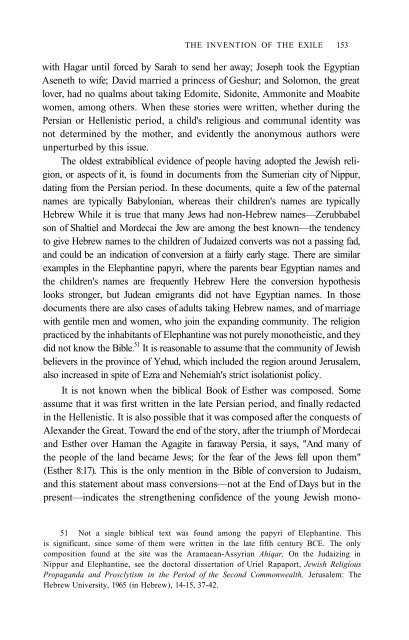Shlomo Sand, The Invention of the Jewish People - Rafapal
Shlomo Sand, The Invention of the Jewish People - Rafapal
Shlomo Sand, The Invention of the Jewish People - Rafapal
Create successful ePaper yourself
Turn your PDF publications into a flip-book with our unique Google optimized e-Paper software.
THE INVENTION OF THE EXILE 153<br />
with Hagar until forced by Sarah to send her away; Joseph took <strong>the</strong> Egyptian<br />
Aseneth to wife; David married a princess <strong>of</strong> Geshur; and Solomon, <strong>the</strong> great<br />
lover, had no qualms about taking Edomite, Sidonite, Ammonite and Moabite<br />
women, among o<strong>the</strong>rs. When <strong>the</strong>se stories were written, whe<strong>the</strong>r during <strong>the</strong><br />
Persian or Hellenistic period, a child's religious and communal identity was<br />
not determined by <strong>the</strong> mo<strong>the</strong>r, and evidently <strong>the</strong> anonymous authors were<br />
unperturbed by this issue.<br />
<strong>The</strong> oldest extrabiblical evidence <strong>of</strong> people having adopted <strong>the</strong> <strong>Jewish</strong> religion,<br />
or aspects <strong>of</strong> it, is found in documents from <strong>the</strong> Sumerian city <strong>of</strong> Nippur,<br />
dating from <strong>the</strong> Persian period. In <strong>the</strong>se documents, quite a few <strong>of</strong> <strong>the</strong> paternal<br />
names are typically Babylonian, whereas <strong>the</strong>ir children's names are typically<br />
Hebrew While it is true that many Jews had non-Hebrew names—Zerubbabel<br />
son <strong>of</strong> Shaltiel and Mordecai <strong>the</strong> Jew are among <strong>the</strong> best known—<strong>the</strong> tendency<br />
to give Hebrew names to <strong>the</strong> children <strong>of</strong> Judaized converts was not a passing fad,<br />
and could be an indication <strong>of</strong> conversion at a fairly early stage. <strong>The</strong>re are similar<br />
examples in <strong>the</strong> Elephantine papyri, where <strong>the</strong> parents bear Egyptian names and<br />
<strong>the</strong> children's names are frequently Hebrew Here <strong>the</strong> conversion hypo<strong>the</strong>sis<br />
looks stronger, but Judean emigrants did not have Egyptian names. In those<br />
documents <strong>the</strong>re are also cases <strong>of</strong> adults taking Hebrew names, and <strong>of</strong> marriage<br />
with gentile men and women, who join <strong>the</strong> expanding community. <strong>The</strong> religion<br />
practiced by <strong>the</strong> inhabitants <strong>of</strong> Elephantine was not purely mono<strong>the</strong>istic, and <strong>the</strong>y<br />
did not know <strong>the</strong> Bible. 51 It is reasonable to assume that <strong>the</strong> community <strong>of</strong> <strong>Jewish</strong><br />
believers in <strong>the</strong> province <strong>of</strong> Yehud, which included <strong>the</strong> region around Jerusalem,<br />
also increased in spite <strong>of</strong> Ezra and Nehemiah's strict isolationist policy.<br />
It is not known when <strong>the</strong> biblical Book <strong>of</strong> Es<strong>the</strong>r was composed. Some<br />
assume that it was first written in <strong>the</strong> late Persian period, and finally redacted<br />
in <strong>the</strong> Hellenistic. It is also possible that it was composed after <strong>the</strong> conquests <strong>of</strong><br />
Alexander <strong>the</strong> Great. Toward <strong>the</strong> end <strong>of</strong> <strong>the</strong> story, after <strong>the</strong> triumph <strong>of</strong> Mordecai<br />
and Es<strong>the</strong>r over Haman <strong>the</strong> Agagite in faraway Persia, it says, "And many <strong>of</strong><br />
<strong>the</strong> people <strong>of</strong> <strong>the</strong> land became Jews; for <strong>the</strong> fear <strong>of</strong> <strong>the</strong> Jews fell upon <strong>the</strong>m"<br />
(Es<strong>the</strong>r 8:17). This is <strong>the</strong> only mention in <strong>the</strong> Bible <strong>of</strong> conversion to Judaism,<br />
and this statement about mass conversions—not at <strong>the</strong> End <strong>of</strong> Days but in <strong>the</strong><br />
present—indicates <strong>the</strong> streng<strong>the</strong>ning confidence <strong>of</strong> <strong>the</strong> young <strong>Jewish</strong> mono-<br />
51 Not a single biblical text was found among <strong>the</strong> papyri <strong>of</strong> Elephantine. This<br />
is significant, since some <strong>of</strong> <strong>the</strong>m were written in <strong>the</strong> late fifth century BCE. <strong>The</strong> only<br />
composition found at <strong>the</strong> site was <strong>the</strong> Aramaean-Assyrian Ahiqar, On <strong>the</strong> Judaizing in<br />
Nippur and Elephantine, see <strong>the</strong> doctoral dissertation <strong>of</strong> Uriel Rapaport, <strong>Jewish</strong> Religious<br />
Propaganda and Prosclytism in <strong>the</strong> Period <strong>of</strong> <strong>the</strong> Second Commonwealth, Jerusalem: <strong>The</strong><br />
Hebrew University, 1965 (in Hebrew), 14-15, 37-42.




